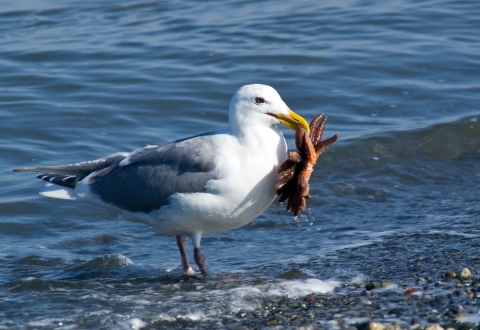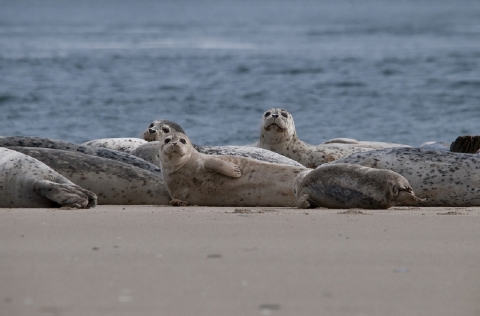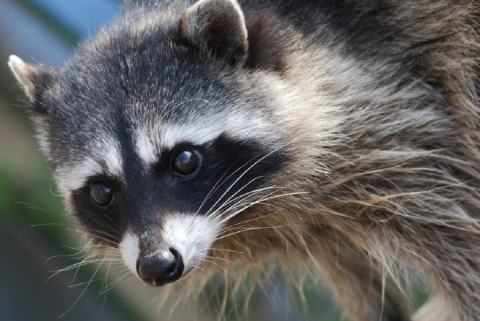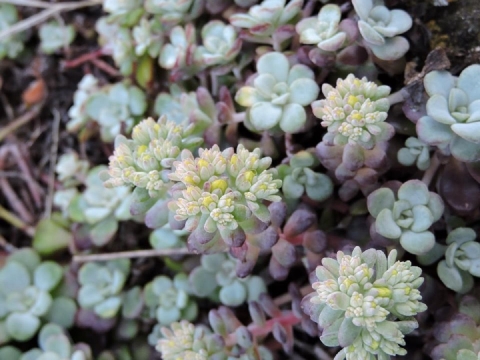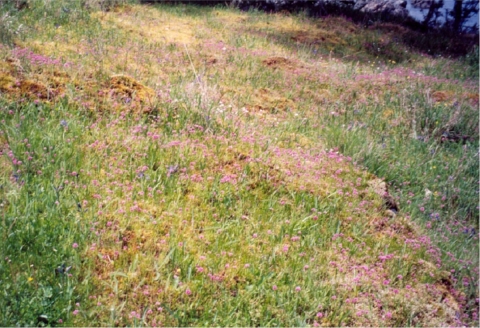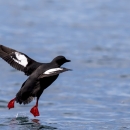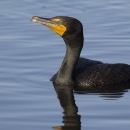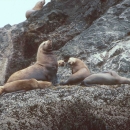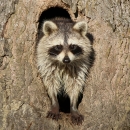Featured Species
Here a just a few of the many species of birds and mammals that rely on the spectacular and rugged San Juan Islands environment for survival.
Birds
A great variety of birds frequent the Refuge. With patience and a keen eye, it is possible to spot cormorants (pelagic, double-crested, and Brandt’s), pigeon guillemots, glaucous-winged gulls, black oystercatchers, brant geese, harlequin ducks, black and ruddy turnstones, rock sandpipers, surfbirds, dunlin, black-bellied plovers, sanderlings, wandering tattlers, western sandpipers, brown pelicans, Heermann’s gulls, killdeer, Caspian terns, peregrine falcons, great blue herons, and many other bird species.
Seabirds of the Pacific Northwest Brochure
Black Oystercatcher
Black oystercatchers, with their bright orange beaks in vibrant contrast to their dark bodies, can be seen year-round in the Salish Sea. They feed on limpets and mussels along the rocky shoreline and build spare nests from shell and pebbles just beyond the water's reach. About eighty percent of breeding pairs in the Salish Sea nest on refuge islands.
Pigeon Guillemot
Pigeon guillemots are widespread throughout the Refuge and are easily identified by their chunky black bodies, white wing patches, and bright red feet. They forage in the water close to shore for small fish and nest in the cavities and crevices of the rocky islands.
Glaucous-winged Gull
Glaucous-winged gulls form raucous colonies in low vegetation. Working together they harass predators by diving and calling alarms to keep the colony safe. They are opportunistic eaters. A healthy gull diet includes crab, clam, and limpets, but they are often tempted by deadly bits of plastic and trash left behind by careless humans.
Double-crested Cormorant
Double-crested cormorants can be seen throughout the islands roosting on shorelines and pilings. They are the largest of the cormorants with a primarily black body and a distinctive orange "face mask". They are highly sensitive to disturbance and will abandon nests if harassed.
Mammals
In addition to land mammals such as black-tailed deer, raccoons, mink, and river otters, four species of seals utilize Refuge shorelines; Steller and California sea lions, and harbor and northern elephant seals.
Harbor Seal
With their sleek spotted heads harbor seals are often seen swimming offshore in the San Juans. They haul out to rest and birth pups on many of the Refuge islands. One of the greatest threats to the harbor seal population is human disturbance, particularly during pupping season. Seal pups resting on shore should always be left alone as their mothers are likely waiting off shore and will not return until humans are clear of the area.
Stellar Sea Lion
Large and buff to brown in color, Stellar sea lions can occasionally be spotted hauled out on Refuge islands. Look for external ear flaps to distinguish them from seals. The Refuge provides important places for them to rest with minimal disturbance.
Raccoon
Raccoons are marked by a distinctive black mask and ringed tail. Wild raccoons are partial to feeding on animals found at the water's edge such as clams and shellfish, but become a nuisance when they find access to human foods. When camping on Turn and Matia Island proper food storage is vital to keeping these animals wild. Come prepared to secure food and garbage in hard-sided containers tied with extra bungee cords or rope.
Habitat
The San Juan Islands NWR is located within the San Juan Archipelago, at the convergence of the Strait of Juan de Fuca and the Strait of Georgia. Geologically, the 83 small rocks, islands, and reefs comprising the Refuge contain extensive sedimentary, metamorphic, and/or volcanic bedrock which are occasionally overlain with glacial and alluvial deposits, particularly on the larger islands. The combination of these soil characteristics, near-drought conditions during the summer months, and highly variable topography results in a diverse assemblage of plant communities and ecological systems.
Shoreline
The shoreline habitat varies greatly throughout the many Refuge islands. Most common are low, rocky shores, sand and gravel pocket beaches are spread sporadically throughout the islands, and some islands have looming, rocky cliffs. Wildlife found along these shorelines include cormorants, black oystercatchers, pigeon guillemots, and harbor seals. Sea level rise is an on-going concern for the shoreline habitats as this can lead to increased erosion, flooding, and over-wash during storms.
Grassy Balds
Most of the small islands in the Refuge are devoid of significant vegetation. A few of the islands are large enough to support patches of herbaceous, or grassy, balds. In these patches a few unusual species thrive including California buttercup and bear's foot sanicle. More common plants found on the islands include white-flowered death camas, paintbrush, and common camas.
Forests and Woodlands
Only ten islands in the Refuge are large enough to support forests. In drier, less protected areas such as ridge tops and south or west facing slopes the forests are composed mostly of Douglas fir and madrone trees. In damper valleys or on north facing slopes Douglas fir and western hemlock trees dominate the habitat and are sometimes joined by western red cedars and grand firs. These forest sanctuaries provide homes for bald eagles, woodpeckers, great horned owls, and bats.




